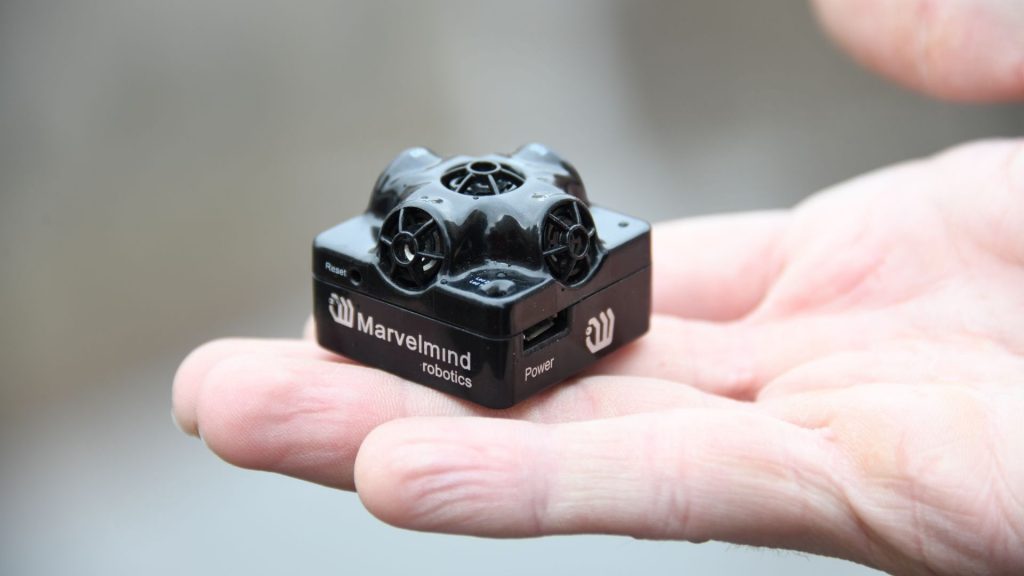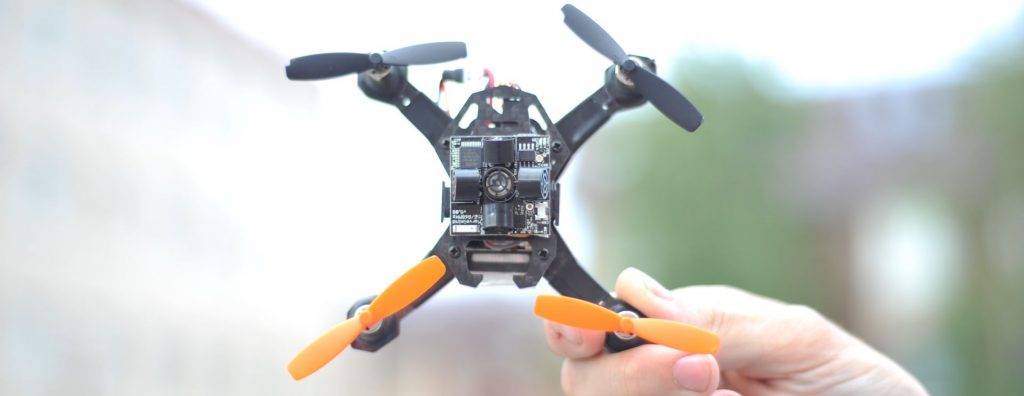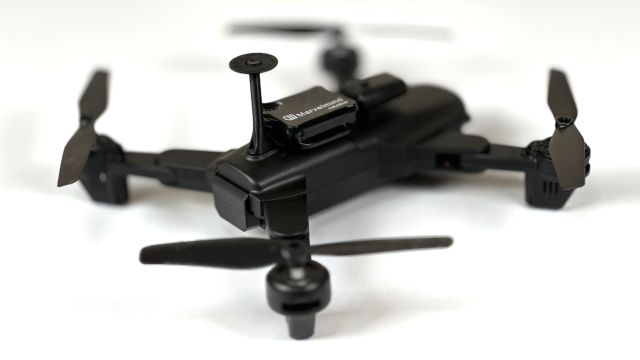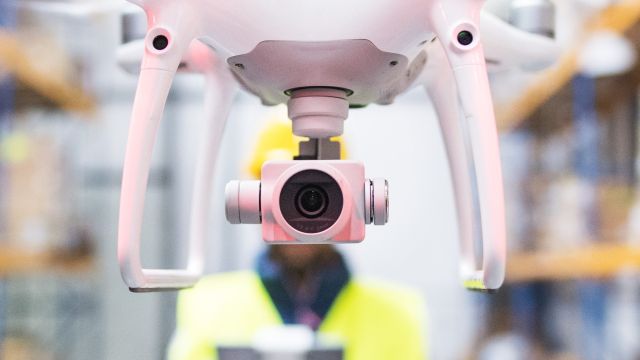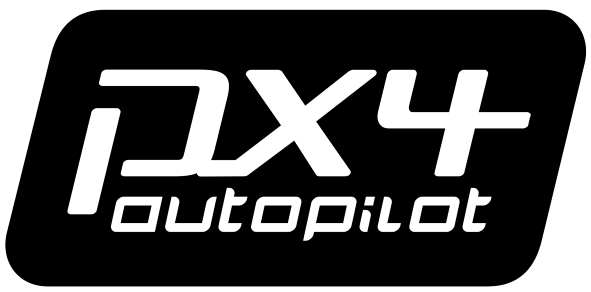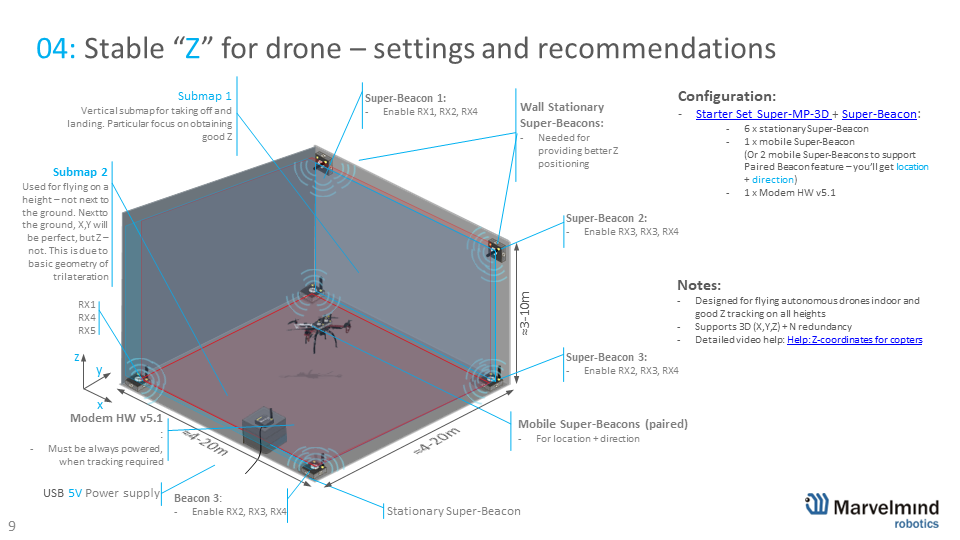Indoor positioning solutions for autonomous drones
We explain how to design and build autonomous indoor drones and what indoor positioning systems to use to track indoor drones when they are not autonomous.
Though we focus on indoor drones and autonomous drone indoor navigation, the drone positioning system works perfectly well outdoors. It just requires outdoor-protected beacons, for example, Super-Beacons-Outdoor.
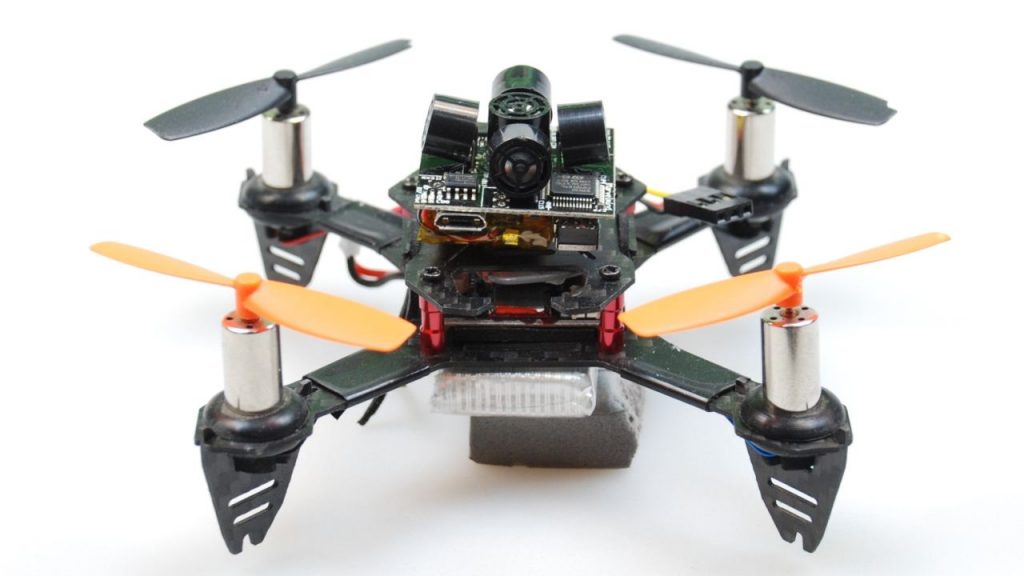
Other Marvelmind sources of help related to drones
- Customer success: Autonomous flight of indoor drone based on PixHawk + ArduPilot
- Powering beacons with external power supply
- Indoor positioning system for drone competition
- How many stationary beacons do we need to cover our office space for autonomous indoor patrolling drone?
- Using IA for drones
- Tracking DJI indoor: two-room edition
- Precise XYZ tracking for indoor drone swarms and indoor drone shows
- Autonomous drone landing pad
- Accuracy degradation in precise indoor position system and how to avoid it
- Help: PixHawk + PX4 + Paired Beacons for Location + Direction instead of magnetometers
- Help: Flying autonomous drones for inspection in a warehouse
- Tracking of micro-drone indoor over long distance
- Micro-drone tracking with Real-time Player enabled
- Micro-drone tracking with Real-time Player disabled
- Precise (±2 cm) indoor tracking in XYZ without GPS/GLONASS
- Precise (±2 cm) drone tracking outdoor without GPS/GLONASS – horizontal flight on two echelons
- Fully autonomous flight indoor
- Help: placing mobile beacon on the copter
- Help: Z-coordinates for copters – long explanation
- Copter traced outdoor with a few centimeters precision
Recommended indoor RTLS for drones - quick hints
When you are new to the Marvelmind Indoor “GPS” system and are unsure what to choose, get the Starter Set Super-MP (MP stands for multi-purpose), which (MP stands for multi-purpose), and that would be your safest choice.
For more specifics, study the recommended options below.
Overall the best and safest choice when you are not sure what to choose or what exact experiments you will run, but you want to simultaneously have the greatest flexibility and performance.
It is the best choice when you need to connect to PixHawk because two pins for the connection to PixHawk are readily available on the Super-Beacon. See more.
Configuration:
– https://marvelmind.com/product/starter-set-super-mp-3d/
– https://marvelmind.com/product/super-beacon/ – an additional mobile beacon for the Paired Beacons configuration to have both location and direction. See more about the Paired Beacons demo
The set is designed for micro-drones (<100g) because the Mini-TX mobile beacon is tiny and light. It is easily 15-20m, sufficient for most real cases. The set can also be used for larger drones, but the ultrasound range Mini-TX is smaller than that of Super-Beacons or Beacons HW v4.9.
Mini-TX is excellent for tracking. The new version of Mini-TX-2 is also ideal for connecting to PixHawk because it has a special 6-pin connector with two pins dedicated to PixHawk connectivity (TX + GND) – similar to those of the Super-Beacon. Notice that older Mini-TX – delivered in 2022 and earlier didn’t have the 6-pin connector on the bottom.
Configuration:
– https://marvelmind.com/product/starter-set-nia-03-smalldrone
An advanced version of the “Starter Set Super-MP-3D + Super-Beacon – Location+Direction on the drone” option.
The Precise-Z, which physically consists of 2 additional stationary beacons, gives the possibility to have precise Z coordinates in all ranges of Z.
See more:
– Placement Manual – Precise-Z slide
– Video explanation about Z and placement of beacons
Configuration:
– https://marvelmind.com/product/starter-set-super-mp-3d/
– https://marvelmind.com/product/super-beacon/ – an additional mobile beacon for the Paired Beacons configuration to have both location and direction. See more about the Paired Beacons demo
– https://marvelmind.com/product/super-beacon/ – additional stationary beacons for Precise-Z feature
If you want outdoor protection, then we don’t have ready sets. But you can gather the set by replacing Super-Beacons with Super-Beacons-Outdoor and Modem v5.1 with Modem v5.1-Outdoor.
If you are not sure, just send us an email to info@marvelmind.com with detailed questions and we will be happy to help and advise.
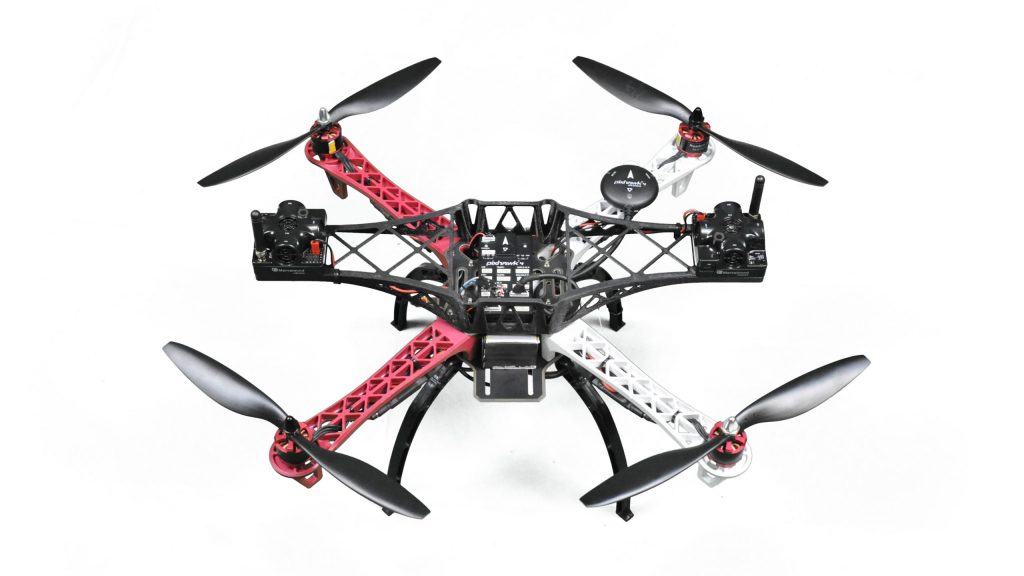
Using Marvelmind Indoor "GPS" for drones and quadcopters
Marvelmind indoor positioning system or Marvelmind Indoor “GPS” is widely used for drones or quadcopters in many different ways:
- Guiding autonomous indoor drones and outdoor drones. Outdoor drones – guiding for “the last mile,” which can be hundreds of meters, if needed, but the maximum distance from the mobile beacon on the drone to three or more stationary beacons serving the mobile beacon must not exceed
- Tracking indoor drones
- Automatic indoor and outdoor drone landing or drone landing assistance
- Warehouse inspection using autonomous indoor drones
- Drone shows
The indoor positioning system for a small drone is not different from other indoor positioning systems, for example, for larger drones or any other 3D (XYZ) indoor positioning systems.
The only peculiarity is the weight of the mobile beacon (tag) installed on the drone. It is solved using a stripped-down version of Mini-TX: removing the shell, removing the battery, or replacing it with a very light battery.
Also, the smaller drones are usually dumb – they don’t have an onboard computer or autopilot, for example, PixHawk and similar. All intelligence comes from the ground station. But with that, there are exceptions.
Drone swarms and drone shows may include tens or even hundreds of drones. When they fly outdoors, RTK GPS does the job very well. But RTK GPS doesn’t work indoors.
IA shall be used if the indoor drone swarm consists of dozens of drones. But in IA, the mobile beacon is listening to the ultrasound, i.e., special solutions shall be used to combat the noise from propellers and keep the system functioning well. Learn more about the solution.
We are approached with requests for autonomous drones or indoor positioning systems for autonomous indoor drones for warehouse inspection, automated barcode scanning, or RFID reading, at least on a weekly basis.
There is certainly a solid need for the task and a strong interest in fulfilling the need based on drones.
Building such a system for real-life applications is very complex but doable. Let’s discuss the details of the implementation.
Fragility of solution is the biggest practical concern. However, there are solutions and even robust alternatives.
Marvelmind Indoor "GPS" supports PixHawk with ArduPilot and PX4
Marvelmind Indoor “GPS” supports both PixHawk with ArduPilot and PX4:
- Marvelmind and ArduPilot – link to ArduPilot.org
- Marvelmind and PX4 Integration Manual – step-by-step guidance with settings and screenshots for Mission Planner, PixHawk, and the HW connectivity
- PixHawk and Marvelmind Integration Manual – a step-by-step guide for PixHawk, ArduPilot, and Marvelmind integration for drones
Marvelmind and PixHawk
Using a combination of Marvelmind Indoor “GPS” and PixHawk is the easiest and quickest way to fly indoors autonomously.
Build indoor positioning system for quadcopters properly
There are several but rather simple aspects that have to be taken into account to fly indoors successfully:
- Autonomous copter settings manual – basic and practical recommendations for setting up of Indoor “GPS” system for usage with autonomous copters/drones indoor and outdoor
- Placement Manual – practical advice and examples of how to mount the Marvelmind Indoor “GPS” system to achieve the best performance in different applications and configurations
- Help: Z-coordinates for copters – long explanation – YouTube explaining how to place the stationary beacons properly to get good Z accuracy. If you can’t use the advice because your environment doesn’t let you use the Precise Z configuration with 4+2 stationary beacons
See the Products page for different starter set options.
Remember that just three stationary beacons would have little resiliency against obstructions for 3D (XYZ) tracking. Any occlusion of any stationary beacon – a non-line of sight/hearing situation – will lead to no tracking or erroneous tracking – like in GPS: “no satellites visibility = no GPS coordinates = no tracking”.
Thus, we recommend at least N+1 redundancy for stationary beacons. And that is why our starter sets for 3D consist of 4 stationary beacons.
Even better is to have 2N redundancy with fully overlapping 3D submaps. That would be either 3+3 or 4+4 stationary beacons. The system would automatically choose the best submap for tracking. That kind of system is very resilient, and with proper placement of the beacons, you can fly even in complex rooms with columns, for example, without tracking issues.
The key to excellent tracking is to provide proper coverage at any flight point, i.e., the mobile beacons on the drone must have three or more stationary beacons belonging to the same submap with a clear, direct line of sight/hearing within 30m.
The proper placement is usually the key and vital to drones because they require 3D; the drones are fast, and the mistakes may be particularly costly. What to pay attention to?
- The most critical requirement for good tracking or autonomous flight – provide a clear line of sight/hearing visibility from the mobile beacons on the drone to 3 or more stationary beacons
- Don’t rely on magnetometers indoors. Use the Paired Beacons configuration for Location+Direction
- Place stationary beacons so that angles from the mobile to the stationary beacons would be 30 degrees or more. See a longer explanation in the video
- Use the Precise-Z configurations when not possible to achieve proper angles to the stationary beacons otherwise
Tracking one indoor drone in one large open space is very easy. With a Starter Set Super-MP or Starter Set NIA-SmallDrone, the precise 3D tracking system can be set in 10-15 minutes, including unpacking and software updates to a set that just was received. If you have made all initial software updates prior to the setup, the system can be deployed in less than a minute.
Autonomous flight is a significantly more complex task because you need to precisely track a drone and integrate its autopilot with the drone/chassis, which is typically made from different parts (chassis, motors, motor drivers, telemetry, remote control). And on top of this, the autopilot must be integrated with the indoor positioning system as described above.
If autonomous flight by a single drone is a challenging task, then autonomous flight by a swarm of drones is the pinnacle of this complexity pyramid. It is even more challenging but still doable if you do it one step at a time.
Before we deeply submerge into the indoor drone swarms, let’s answer the basic question: “How are those thousands of drones flying in the sky?” – well, it is straightforward – they use the RTK GPS positioning system. But, remember, the RTK GPS relies on GPS. If there is no GPS, there is no RTK GPS either. Thus, as soon as we move indoors or other GNSS-denied areas, forget about the GPS (GLONASS, Beidou, Galileo, etc.)
Small drones are too small. Large drones are too large
Having a massive swarm of small drones and playing a nice show would be great. However:
- Battery size vs. show time vs. drone size
- Autopilot and the indoor positioning system have a non-zero mass. There is a limitation on the bottom on the size of the drones
- Drones need direction. Direction is best achieved by two or more location points on the drones. The farther they are, the better angular accuracy
If drones are too big:
- It is difficult to keep them separate. You need a larger safe distance between them and, as a result, a larger space for the show
- Larger drones are heavier, noisier, and more dangerous. Noise and protection nets can ruin the whole idea of the show
Keep drones believing they are alone
In many cases, it is possible to set the autonomous flight by multiple drones so that they are not even aware that there are other drones around. They believe they are so unique and so exceptional. It is in your interest to keep them in this naive belief because it is the simplest way to make drone swarms.
Examples of configurations of indoor positioning system for drone shows based on Marvelmind Indoor "GPS"
Using a combination of solutions, it is possible to fly a swarm of drones using IA: Indoor positioning system for drone shows and swarms.
This complex solution may not be suitable if you are new to our system or drones in general. But it offers the best performance for indoor drone shows because it allows flying multiple autonomous drones without the location update rate reduction and offering the highest ±2cm positioning accuracy.
Configuration:
- IA
- 4 x https://marvelmind.com/product/super-beacon/ – stationary beacons placed around and above the flying area
- 1 x Modem v5.1
- 10 x Mini-RX + Microphone – a hybrid mobile beacon for each drone
As discussed above, the first thing to decide is whether you need direction based on the Paired Beacons. If you need, then you need two mobile beacons per drone. If you don’t need it, only one mobile beacon per drone.
It is possible to fly with a single mobile beacon, but the SW on the autopilot must be more complex – not out of the box because it shall provide the direction and correction of the drone’s gyro’s drift while it is flying. It is complex. Doable. But complex. And if only possible, we always recommend the Paired Beacons configuration as an easy solution for indoor direction, even in static.
However, as discussed above, for swarm drones or indoor drone shows, it may not be the best option. Thus, we will assume a more complex and fragile option based on a single mobile beacon as a drone’s main variant.
Configuration:
- MF NIA – MF NIA is strongly recommended for drone swarms because NIA would be too slow, and drones may be too noisy for IA
- 4 x https://marvelmind.com/product/super-beacon/ – stationary beacons placed around and above the flying area
- 1 x Modem v5.1
- 10 x Super-Beacons – mobile beacons for ten drones
- 14 x MF NIA licenses
If your drones are tiny and cannot carry a 27g load (a stripped-down version of the Super-Beacon), then the Mini-TX without additional battery and housing is your best choice. In the stripped configuration, it is just 6.7g.
However, the Mini-TX works only on one frequency (31kHz). Thus, only NIA remains your option. Therefore, if you have ten drones, the location update rate per drone will be 1/10 of the system location update rate. For a small submap of 5x5m, it is possible to get 20-25Hz per system. Thus, per drone, the location update rate will be ~2-2.5Hz. This location update rate is suitable for slow-moving shows. But still, it is much better than nothing.
Configuration:
- NIA
- 4 x https://marvelmind.com/product/super-beacon/ – stationary beacons placed around and above the flying area
- 1 x Modem v5.1 – a central controller of the system. You can monitor the data and control the drones through it
- 10 x Mini-TX – mobile beacons for ten drones
UWB-based systems
UWB-based indoor drone positioning systems don’t differ much in principle from the Marvelmind Indoor “GPS”. Of course, the underlying technology is different (time of flight of UWB compared to the time of flight of ultrasound). But the architecture and the network elements are very similar.
Practical differences between UWB and Marvelmind Indoor “GPS”:
- UWB is about ten times less accurate than ultrasound, i.e., the drones are more stable in the air
- However, UWB is not affected by the acoustic noise of the drones in principle
- UWB can support more drones at the same time in principle. Whether or not the UWB supports more drones in reality and the resulting update rate per drone depends on the UWB system implementation. IA-based systems can easily rival UWB-based systems in terms of capacity and surpass them in terms of accuracy by a factor of ten
Optical systems - QR codes around
Becomes more and more popular due to potential simplicity:
- A camera is facing down to QR codes (or other special patterns) on the floor. QR codes provide both location and direction
- QR codes can be above the drones (ceilings), if more convenient
- QR codes may be around the drone, but then more cameras or special “fish-eye” cameras are required
Pros:
- Relatively inexpensive positioning system
- No need in active beacons around
Cons:
- A need for QR codes around – sometimes, they are either undesired or even impossible
- Requirements to special lighting
- Triangulation based system, thus, QR codes must be dense and pretty near or accuracy of position suffers
Consider an alternative: Autonomous drone landing pad.
Motion capture-based systems
Very impressive drone shows lead us to believe that drones are so intelligent. However, the view is very deceiving. The positioning system is a pearl of the setup – not the drones. Drones are rather dumb. They are not even aware that they are tracked. Besides, they are entirely remotely controlled based on the location data from the tracking system. Thus, they are even dumber. But it is okay. It doesn’t matter how the feat is achieved as soon as the performance is impressive and truly impressive.
Motion capture-based systems:
- They are expensive or very expensive because they require fast high-resolution infrared cameras, a lot of data connection (cabling) between the cameras and the central computer, expensive power computer, and special infrared lighting
- They are naturally limited in the covered area because the location is based on triangulation, and they are typically limited to 10x10m or so
- On the good side, the trackers on the drones are light and passive – just light reflectors
Examples of of implementation of precise indoor positioning, tracking, and navigation for drones on Marvelmind Indoor "GPS"
Precisely (±2cm) tracking DJI Phantom quadcopter indoor in 3D (XYZ)
- Precise tracking in X,Y,Z (XY view + XZ view + YZ view)
- Raw data and post-processed data from Dashboard’s Player – notice that today the same is available not in the post-processing but in the Real-Time Player
- The DJI ecosystem is closed, at least, for the Phantom and Mavic series. Thus, it is possible to track the Phantom but not fly autonomously indoors (without deeper hacking)
- Learn more about Flying DJI drones autonomously indoor
Precisely (±2cm) tracking DJI Phantom quadcopter outdoor in 3D (XYZ)
- Precise (±2cm) tracking in XYZ (XY view + XZ view + YZ view) – the same as above, but outdoor
- The same Precise-Z configuration consisting of 4+2 stationary beacons is used in this demo and above. See more in the Placement Manual
- Learn more about Flying DJI drones autonomously indoor
Fully autonomous flight indoor
- Small copter is flying fully autonomously relying on Marvelmind Indoor “GPS”
Using IA for indoor drone tracking and indoor drone swarms
With a combination of solutions, it is possible to use IA for indoor drone positioning:
- Special ultrasound deflector protecting the microphone from the own propellers’ noise
- Placing stationary beacons clearly above the drone
- Using special sharp and narrow DSP filters
Indoor tracking small and micro-drones
It is possible to track even micro-drones (less than 100g) with the help of Mini-TX beacons.
Starter Set NIA-SmallDrone is specifically designed for this kind of drones.
The minimum configuration for the drone tracking would be any NIA set with 3D capability. For example, three stationary beacons + 1 mobile beacon + 1 modem and Non-Inverse Architecture (NIA) or Multi-Frequency NIA (MF NIA) would already be OK for the drone.
Drones for warehouse inspection
Using drones for warehouse inspection is pretty popular – finding lost pallets, security, etc. Yes, it is a doable task but very complex in practice:
- Very challenging environment in general
- Drones fall and break => high cost of error
- Drones are potentially dangerous to fly and to challenging to develop and use
Nevertheless, the solution is up-and-coming. Thus, drone builders or builders of warehouse systems use our indoor positioning system for such solutions. In the video, we explain the peculiarities of the environment (narrow aisles and high shelves), how the peculiarities affect accuracy, and how to build the system optimally.
Autonomous landing platform for drones
It is possible to build an autonomous landing platform for a drone. It can even be a moving one:
- You place four stationary Super-Beacons facing up on the edges of the platform. The larger platform – the better accuracy of the distance
- You put two mobile Super-Beacons facing down
Drone flies using regular RTK GPS or even GPS when it is far and up to 30m from the platform. It is locked to the Indoor “GPS” coordinates and is landing based on these coordinates. As mentioned, the platform may be static against the Earth or moving. It doesn’t matter for the drone. So, you can precisely land on a moving vehicle, for example.
Autonomous flight by our customers
Autonomous flight by our customers with Pixhawk + Marvelmind
"Can I fly DJI Mavic autonomously indoor?
It is easy to track DJI drones indoors. However, flying DJI drones autonomously indoors is more complicated.
Learn more about Flying DJI drones autonomously indoors.
